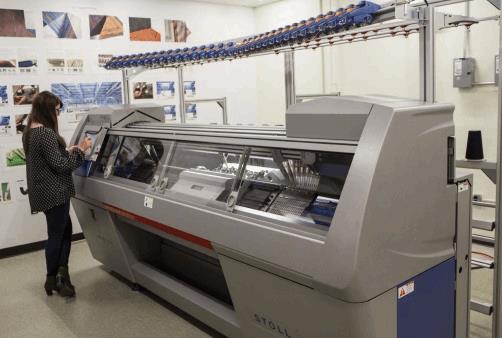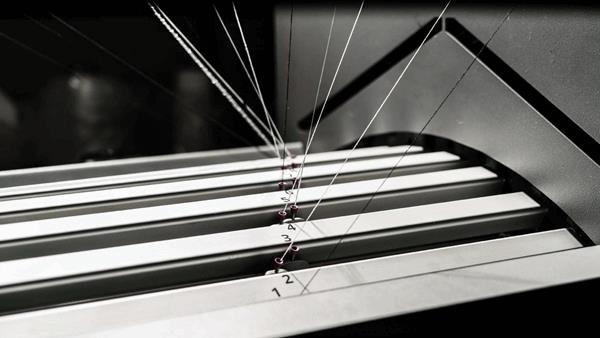How Digital Knitting Can Stitch A Better Bottom Line On Medical Wearables

By Stephannie Kia, Priority Designs
As the need for innovative, wearable medical devices increases, so does the importance of new prototyping methods to expedite development time and reduce the time to market. Within soft goods development, digital knitting offers an innovative approach to prototyping that allows for intricately detailed 3D shapes, and for multiple materials to be integrated into a single, production-level prototype.
The term “soft goods” generally is used to describe a type of fabric-based product assembled using a variety of methods. Cut-and-sew, radio frequency (RF) welding, compression molding, and digital knitting are the most common methods of production. It also is common for soft good products to incorporate hard goods - such as plastic shells or foam padding - molded over the soft materials. The range of soft goods products includes fashion garments, backpacks, upholstery, personal protective equipment, wearable medical devices, and sports equipment.
Cut-And-Sew
The most widely adopted production method is cut-and-sew. Cut-and-sew is a process of design and construction that creates a product prototype by hand, develops 2D patterns based on that prototype, and then uses the patterns to cut raw materials. After the patterns are cut from the appropriate materials, they are hand-assembled using a sewing machine. One of the main benefits of cut-and-sew is that developers are not limited to fabric types, pattern geometries, or sewing methods to create their product. Cut-and-sew allows for the designer to build in details like material break-ups, darts, pleats, and curvature by manipulating the fabric and adding seams to the design.
Though tried and true, cut-and-sew methodology has its limitations. Cut-and-sew is fundamentally a 2D process, in which flat patterns are cut out and stitched together to create products with three dimensions. To achieve 3D contours using flat materials cut from 2D patterns, it is necessary to create seams to allow for three-dimensional structure in the design, but seams are not optimal for strength, material transition, or comfort. Whenever a seam is added, there is a risk of that seam breaking and producing a weakness in the design. In addition, it is difficult to create smooth transitions between fabric types, or to control how ridged or flexible a fabric’s stitch tension will be. This is particularly challenging when developing a wearable medical device, or other medical products that come in contact with skin. Seams can irritate skin and pressure points, as well as cause other issues that have the potential to compromise the skin.
Manufacturing a cut-and-sew product requires a sewing machine and a skilled operator to hand-assemble and sew the product. When a product is constructed by hand, there is a need for increased control of tolerances to offset the likelihood and frequency of human error in assembly. While loose tolerances from hand fabrication might not cause concern on a consumer product, minor errors can have a significant impact on a medical device’s safety and efficacy.
Digital Knitting – Think 3D Printing For fabrics
Much like 3D printing has disrupted the product manufacturing world, digital knitting is poised to do the same for the world of soft goods. The best example of digital knitting early adoption is the footwear industry. Footwear manufacturers have embraced the design, construction, and manufacturing benefits of digital knitting over cut-and-sew methods more than any other. The upper segments of shoes, such as Nike’s Free RN Flyknit running shoes or Hyperdunk Flyknit basketball shoes, are highly technical garments. The user needs specific areas of support, flexibility, comfort, and structure. With its highly controlled and precise design capabilities, digital knitting transforms the material into an engineered textile with specific functional purposes. These machines can incorporate over thirty different yarn types, including carbon fiber and conductive materials, inlayed with the fabric. The two main equipment manufacturers are Germany’s Stoll and Shima Seiki from Japan. Other industries utilizing this technology include furniture companies, such as Herman Miller and Ikea, and automotive manufacturers, including Audi.
 Digital knitting, or fully fashioned design, is a form of automated stitch structures connected through a series of loops to create a final textile within a CAD based environment. With digital knitting, designers can designate particular yarn types to specific geometric zones within the design. This gives the designer total control over the levels of material tenacity, stitch strength, and distance by varying the stitch tensions and types. The flexibility of digital knitting allows the designer to be specific about the placement of yarn types, stitch, or tensions within the design, enabling more creative opportunities, such as producing tubular or seamless structures and allowing machine-reproducible 3D structures.
Digital knitting, or fully fashioned design, is a form of automated stitch structures connected through a series of loops to create a final textile within a CAD based environment. With digital knitting, designers can designate particular yarn types to specific geometric zones within the design. This gives the designer total control over the levels of material tenacity, stitch strength, and distance by varying the stitch tensions and types. The flexibility of digital knitting allows the designer to be specific about the placement of yarn types, stitch, or tensions within the design, enabling more creative opportunities, such as producing tubular or seamless structures and allowing machine-reproducible 3D structures.
The initial phases of development using digital knitting should focus on yarn development, as yarn is the core element to overall knit design. Without proper yarn combinations, the design may not demonstrate the desired strength or last as long as required. There should also be adequate time focused on graded sizing (S, M, L, XL) and fine details in the knit design, as knit fabric is inherently flexible and can grow and contract over time. The designer must test the sizing to ensure the measurements account for these potential changes in the final design.
Allowing more up-front time during development translates to faster lead time to manufacturing, and a smooth transition to production. With the additional time, yarn qualities can be tested to confirm how they react to laundering, how much they shrink, or whether the yarn will pill over time. It is important to test how the product can withstand Velcro or other secondary applications. This testing is critical because it allows the knit technician to counter these issues by adjusting stitch tension to create a tighter knit weave, avoiding pilling and knit growth. When these details are established early, the product has better overall fidelity and will create fewer issues during production, such as yarns breaking or shrinking during final steaming in the factory.
As the design progresses, digital knitting can impact downstream development, as well. Digital knitting speeds up the iterative design process because developers can quickly design, produce, and evaluate prototypes faster than traditional hand fabrication. Since digital knitting allows the designer to control the specific amount of yarn used, the amount of waste generated during manufacturing is greatly reduced. Most importantly, digital knitting opens the door to producing 3D shapes with no seams. Using knitting software to build the stitch design, designers can develop 3D shapes using specific measurements to form the design’s contours. The system knits shapes directly, eliminating the need to cut 2D fabric into pattern shapes and sew them together. Each piece that comes off the machine is within very tight tolerances and less material waste is created.
Example: Creating A Medical Wearable
A recent project we encountered demanded a soft goods solution that would provide comfort, compression, breathability, and discretion for the user. Currently, products in this category all are manufactured using a cut-and-sew elastic solution and, despite being offered in a range of sizes and geometries, do not address issues of comfort, breathability or discretion. Several concepts were designed and prototyped using cut-and-sew methods, compression molding, and digital knitting techniques.
The prototypes were used to conduct in-home formative user testing in the U.S. and E.U. to obtain first-hand knowledge of how each construction method would perform technically, as well as how patients would react to each design. Of the three variations tested, the digitally knit option was universally preferred due to overall comfort and visual aesthetic. Participants wanted a garment that offered support, but was comfortable and did not disrupt their daily activities. Discretion also was a factor, as some participants were shy about telling friends or family about their condition. Participants also gravitated to the digitally knit solution due to the lack of seams and breathability in the knit stitch structure. Users often wanted to visibly see the air flow as a way to monitor their healing and ensure comfort by not overheating. Additionally, participants desired a solution that did not look like a medical device, but rather an active garment. Users want a design that will make them feel uplifted rather than reminding them of their illness.
 The digitally knit prototypes allowed for the designation of specific, targeted areas of breathability by using open-stitch structures in the pattern and specifically designed yarns. For durability, bio-compatible, machine-washable yarn was used, which allows moisture to be wicked away from the material and the skin. The specific knit pattern created a seamless construction that increased the period of time during which the product could be comfortably worn. The aesthetic of the surface pattern helped camouflage dirt and aimed to help promote positive self-image in the eyes of patients and caregivers.
The digitally knit prototypes allowed for the designation of specific, targeted areas of breathability by using open-stitch structures in the pattern and specifically designed yarns. For durability, bio-compatible, machine-washable yarn was used, which allows moisture to be wicked away from the material and the skin. The specific knit pattern created a seamless construction that increased the period of time during which the product could be comfortably worn. The aesthetic of the surface pattern helped camouflage dirt and aimed to help promote positive self-image in the eyes of patients and caregivers.
As a result of positive user feedback, additional iteration and testing loops were not needed. This saved months of development time and negated the need to conduct additional rounds of testing. Since concepts were designed and prototyped digitally, the design intent can be maintained as the digitally knit solution progresses to manufacturing. Once the knit program is designed, the ability to make quick prototype iterations has reduced overall knitting time on the manufacturing floor. With the digital program established, it is as simple as pushing a button and the machine will keep knitting piece after piece. Note that cut-and-sew typically requires pressing to create smooth shapes or opened seams, fastener attachment, and sewing on labels. The after-processing of digital knitting generally includes only steaming and label placement.
Thus, digital knitting transforms textile-based products from cut-and-sewn, 2D patches of fabric to three-dimensional products. It allows the designer unprecedented control over the materials, their functionality, and their ultimate construction. Through digital knitting, it is possible to reduce the amount of time needed to iterate, expediting prototyping and reducing overall development time, as well as eliminating the variances of human handling.
All images courtesy of Priority Designs.
About The Author
Stephannie Kia is a degreed fashion designer, specializing in soft goods design and development. She has diverse experience in pattern-making, cut-and-sew techniques, digital knitting, and the creation of final tech packages. Her extensive textile knowledge stems from experience in retail fashion, which she is bringing to help transform and improve products in the medical industry. Utilizing her skills in technical design, illustration, CAD, construction, and fit, Stephanie integrates the soft goods process from concept and design to prototype testing and final hand-off to manufacturing.
